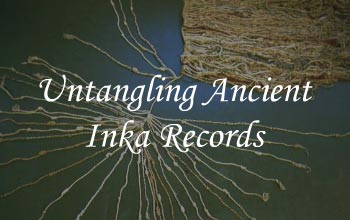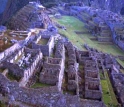News Release 05-137
Inka Textile Devices Served as Business Ledgers
Computer analysis reveals numerical and other patterns in knotted objects
August 11, 2005
This material is available primarily for archival purposes. Telephone numbers or other contact information may be out of date; please see current contact information at media contacts.
While most ancient cultures recorded civil matters and business transactions by inscribing characters on 2-dimensional sheets, new evidence shows Peru's original inhabitants used a 3-dimensional system of knotted strings to keep track of things.
In the Aug. 12 edition of the journal Science, Harvard University anthropologist Gary Urton and database developer Carrie Brezine say their computer analysis of 21 of the knotted objects, known as "khipu," revealed distinct patterns that help confirm the textile devices were used for record keeping and to communicate affairs of state throughout the sprawling empire of the Inka--a spelling Urton prefers because it is closer to the native Peruvian language.
Seven of the objects appeared to contain cumulative numerical data.
Deciphering the khipu information also helps explain how the vast Inka bureaucracy, which ruled the Andes from 1425 to 1532, stayed so organized without ever developing a system of 2-dimensional writing.
According to Urton, khipu were used "to record the information deemed most important to the state, which often included accounting and other data related to censuses, finance and the military." In this regard, he said, "the discovery that khipu were used as ledger books reveals a new consonance between the Inka and other ancient cultures."
The work was supported by the National Science Foundation's Behavioral and Cognitive Sciences program, the Dumbarton Oaks Foundation, Harvard's Faculty of Arts and Sciences and the John D. and Catherine T. MacArthur Foundation.
Read the Harvard news release.
-NSF-
-
Knotted "khipus" probably served as ledgers for Inka building projects like Machu Picchu.
Credit and Larger Version
Media Contacts
Steve Bradt, Harvard University, (617) 496-8070, email: steve_bradt@harvard.edu
Related Websites
Harvard Khipu Web Site: http://khipukamayuq.fas.harvard.edu/
NSF Award for Khipu Database: http://www.nsf.gov/awardsearch/showAward.do?AwardNumber=0408324
NSF Award to Decipher the Khipu: http://www.nsf.gov/awardsearch/showAward.do?AwardNumber=0228038
The U.S. National Science Foundation propels the nation forward by advancing fundamental research in all fields of science and engineering. NSF supports research and people by providing facilities, instruments and funding to support their ingenuity and sustain the U.S. as a global leader in research and innovation. With a fiscal year 2023 budget of $9.5 billion, NSF funds reach all 50 states through grants to nearly 2,000 colleges, universities and institutions. Each year, NSF receives more than 40,000 competitive proposals and makes about 11,000 new awards. Those awards include support for cooperative research with industry, Arctic and Antarctic research and operations, and U.S. participation in international scientific efforts.
Connect with us online
NSF website: nsf.gov
NSF News: nsf.gov/news
For News Media: nsf.gov/news/newsroom
Statistics: nsf.gov/statistics/
Awards database: nsf.gov/awardsearch/
Follow us on social
Twitter: twitter.com/NSF
Facebook: facebook.com/US.NSF
Instagram: instagram.com/nsfgov




